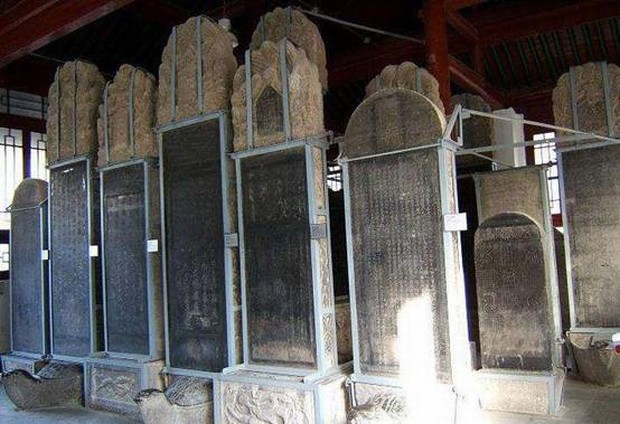The Tang Dynasty (618-907 CE) is remembered today, especially in mainland China, as a golden age of Chinese culture, imperial splendor and military might. Ruling from the dynasty’s capital of Chang’an (contemporary Xi’an), a metropolis possibly boasting a population of a million drawn from all over Eurasia, the Tang emperor held power from Korea in the east to Afghanistan in the west.
But how was that era remembered by the people that followed, after the fall of the Tang? In a recent Fairbank Humanities Series talk, Xin Wen, a historian of medieval China and Inner Asia at Princeton University, examined the stelae (inscribed stone monuments) that were carefully curated by scholars and officials after the Tang, and what he found was a bit of a surprise: In striking contrast to contemporary views of Tang cosmopolitanism, the collectors and curators of the most important stelae, called the “Forest of Stelae,” chose to highlight only the Tang’s promulgation of Confucian Classics and the achievements of mid-Tang belletrists and calligraphers such as Liu Gongquan and Yan Zhenqing.
Rejecting the inclusion of stelae either glorifying Tang emperors’ rule, foreign conquests, or promoting Daoism, to say nothing of inscriptions testifying to the important presence of non-Sinitic communities in Chang’an, the collection’s curators chose to canonize orthodox cultural and literary attainments (or occasionally Buddhism). “The City of Chang’an was remembered in this collection as neither a cosmopolitan cauldron of Eurasian cultures nor a hub of imperial power,” Professor Wen said, “but as a city of Confucian learning and literary culture.”
The contents of the collection has much to tell us about how Chinese literati in succeeding eras, especially the Northern Song (960-1127), Jin (1115-1234) and Yuan (1271-1368) dynasties, consistently perceived the legacy of the Tang. The choice to commemorate these particular stelae seems to be a fascinating example of reshaping history to fit the political needs of the contemporary time.

The stelae are valuable because they are just about all that remains of the original city of Chang’An. The wealth and prosperity of this immense Tang imperium was reflected in an abundance of these monuments produced for a wide variety of purposes by actors including emperors and princes, wealthy and influential families, eunuchs, and Buddhist and Daoist monasteries. No above-ground traces of the palaces and other buildings of Tang-era Chang’an remain. However, from shortly after the Tang’s fall, an enterprise developed among literati of preserving and relocating Tang stelae to within the vastly truncated boundaries of the post-Tang city. Such efforts were sufficient to ensure the survival of a considerable number of such stelae, albeit not the majority, which unfortunately over the centuries succumbed to destruction, often at the hands of local farmers keen to avoid disruptions from would-be collectors.
The stelae that Wen chose to study is the most famous collection, the so-called “Forest of Stelae” 碑林, currently functioning as a museum in southern Xi’an. The research will be featured in Wen’s forthcoming book on the history of post-Tang Chang’an.
Centering around the famous “Stone Classics,” inscribed at imperial order in 837, to which other stelae were gradually added, this collection first emerged in the 10th century. After several relocations, its stelae finally obtained their final resting place next to a Confucian temple in the early twelfth century. Having remained there with a remarkable degree of consistency, the collection has over the centuries attracted considerable numbers of visitors and tourists, being safeguarded and managed by a succession of local officials and elites.
It has long been appreciated that the Tang posed a problem for many Song-era intellectuals, who rejected the Tang’s supposed deviations from standards mandated by the Confucian Classics. Nonetheless, Wen’s research breaks new ground by showing how such views were embedded in local efforts to remember the Tang past by preserving and curating its physical remnants.
More broadly, Wen’s research also reminds us how malleable perceptions of the past remain and that what is valued in one era may shift dramatically in another. History has always been a tricky matter in China, from ancient times to today. Glorification of national power and other uses for which the Chinese government has deployed the Tang legacy alongside much recent western historiography’s emphasis on the Tang-era’s cosmopolitanism are strikingly different to how the Tang’s near contemporaries viewed it. Curating the past remains just as much a political and ideological as an archaeological endeavor.


